As the team now had a direction towards reducing E-Waste, we decided to delve deeper into the problem through secondary research. We created a system map of the e-waste lifecycle based on our research, which helped to identify the problem areas we could tackle to minimise the impact caused by e-waste in our environment. We split the e-waste lifecycle system map into two parts. The first part included consumer behaviour towards recycling, awareness, and the e-waste collection system. The second part comprises sorting, dismantling & shredding, and resource recovery. Instead of just focusing on a single problem area, we did a brainstorming session to come up with solutions for all possible areas so we could pin down the ideal one to focus our attention on.
One of the first activities we did was a whiteboard presentation showcase. With our research findings and the system map, we created a showcase in our classroom, where we explained the overall issue, its causes, the system map, and our initial solution ideas. Our lecturers gave us valuable feedback, which helped us rethink and refine our focus area and proposed solutions.
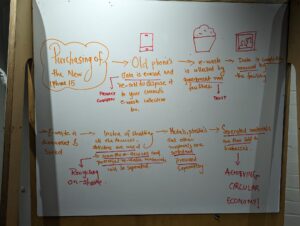
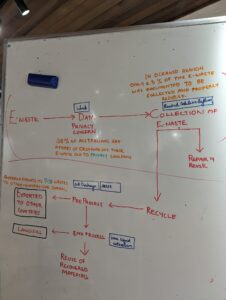

PHASE 1:
As for our project direction in Phase 1, we proceeded with part one of our system map. With the help of our research and data gathered from council webpages, social media platforms, Australia and New Zealand Recycling Platform (ANZRP), research journals and online articles, we analysed the environmental and health hazards posed by increasing e-waste volumes, consumer e-waste recycling behaviour and infrastructure for e-waste collection. A few of our significant findings were that most consumers refused to recycle their e-waste mainly due to data privacy concerns, lack of awareness of e-waste collection points & procedures and a centralised e-waste collection system.
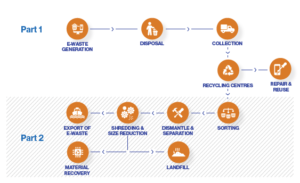
After examining the current e-waste management system, we proposed a three-part solution. Our solutions to tackle the issues we identified were:
- REME: an automated e-waste collection pod integrated with a robotic arm, capable of scanning damages, data removal and sorting devices according to category.
- MIMI: an interactive robot designed for public education and awareness.
- RECYCLE ME: a digital management and communication platform connecting councils and the public for efficient e-waste management.
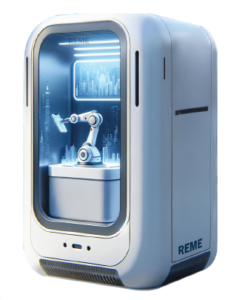


Through these three solutions, we aim to change consumer behaviours towards e-waste recycling, increase public awareness, and standardise recycling practices, thereby reducing the volume of e-waste in landfills and mitigating its adverse impacts on health and the environment by 2030.
We have utilised a few CERN and ATTRACT technologies for our solutions to succeed. We took inspiration from CERN Bot and incorporated ATTARACT’s XCOL CMOS Image Sensor into REME’s Micro-CT scanner. CERN’s data analysis framework is crucial to RECYCLE-ME, our centralised management system, mapping e-waste streams, analysing data to assess the effectiveness of e-waste collection & management initiatives and tracking and visualising critical data in real-time.
As 2024 starts, we will look further into the second part of the e-waste lifecycle, mainly recovering precious and rare earth metals. Considering the vast amount of e-waste generated in Australia, metal recovery through recycling could reduce mining for these metals. Yet, much e-waste gets exported offshore after dismantling and shredding. We look forward to addressing this gap for phase two of the project.
TEAM SNAPSHOT:
Highlight: What we have learned from our lecturers while working towards phase 1 deliverables is that, sometimes, when you feel stuck, it’s better to take a step back and look at all possibilities with an open mind. It is also important to identify what you know and don’t know, then ask yourself if they are important.
Quote: “Almost all new ideas have a certain aspect of foolishness when they are first produced.” ~ Alfred North Whitehead
(While we were brainstorming for ideas, the initial solution concepts of our Phase 1 were somewhat silly. Our first concept of MIMI began as something similar to the Teletubbies! Even REME started as a door-to-door automated e-waste pickup service. Although these ideas seemed foolish then, they were the steppingstones for our current concept.)
Next Steps: Our next step will be looking towards efficient processing of e-waste and material recovery. Of these two, material recovery stands out to us more.

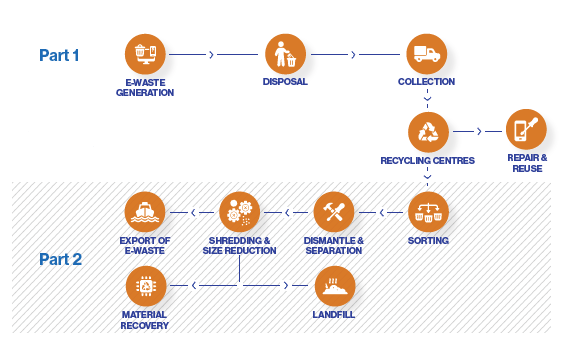
Recent Comments